SOC 103A: Analyzing the Policy Process of National Drug Strategy
VerifiedAdded on 2023/06/11
|6
|1849
|306
Report
AI Summary
This report analyzes the key stages of the policy process within the context of Australia's National Drug Strategy, with a particular focus on Medically Supervised Injecting Centres (MSICs). It discusses the role of MSICs in harm reduction, providing safe environments for drug use, and offering access to healthcare services. The report outlines the four stages of the policy process – goal setting, intervention, pathway of change, and preconditions – and evaluates their implementation in the context of the National Drug Strategy. While acknowledging the benefits of MSICs in reducing harm, the report also considers potential drawbacks, such as the normalization of drug use. The report concludes that MSICs are effective in providing a safer environment for drug users and reducing negative health impacts.
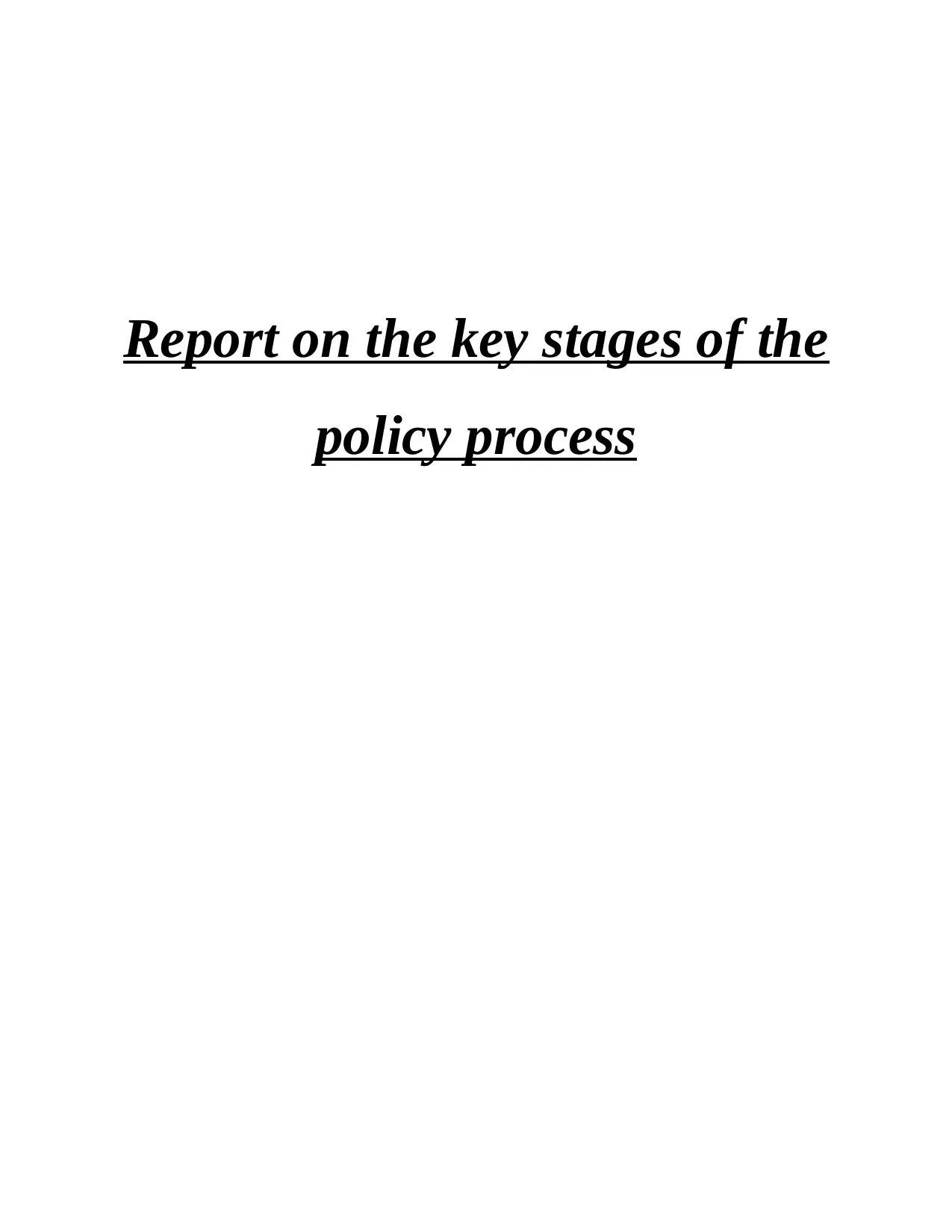
Report on the key stages of the
policy process
policy process
Paraphrase This Document
Need a fresh take? Get an instant paraphrase of this document with our AI Paraphraser
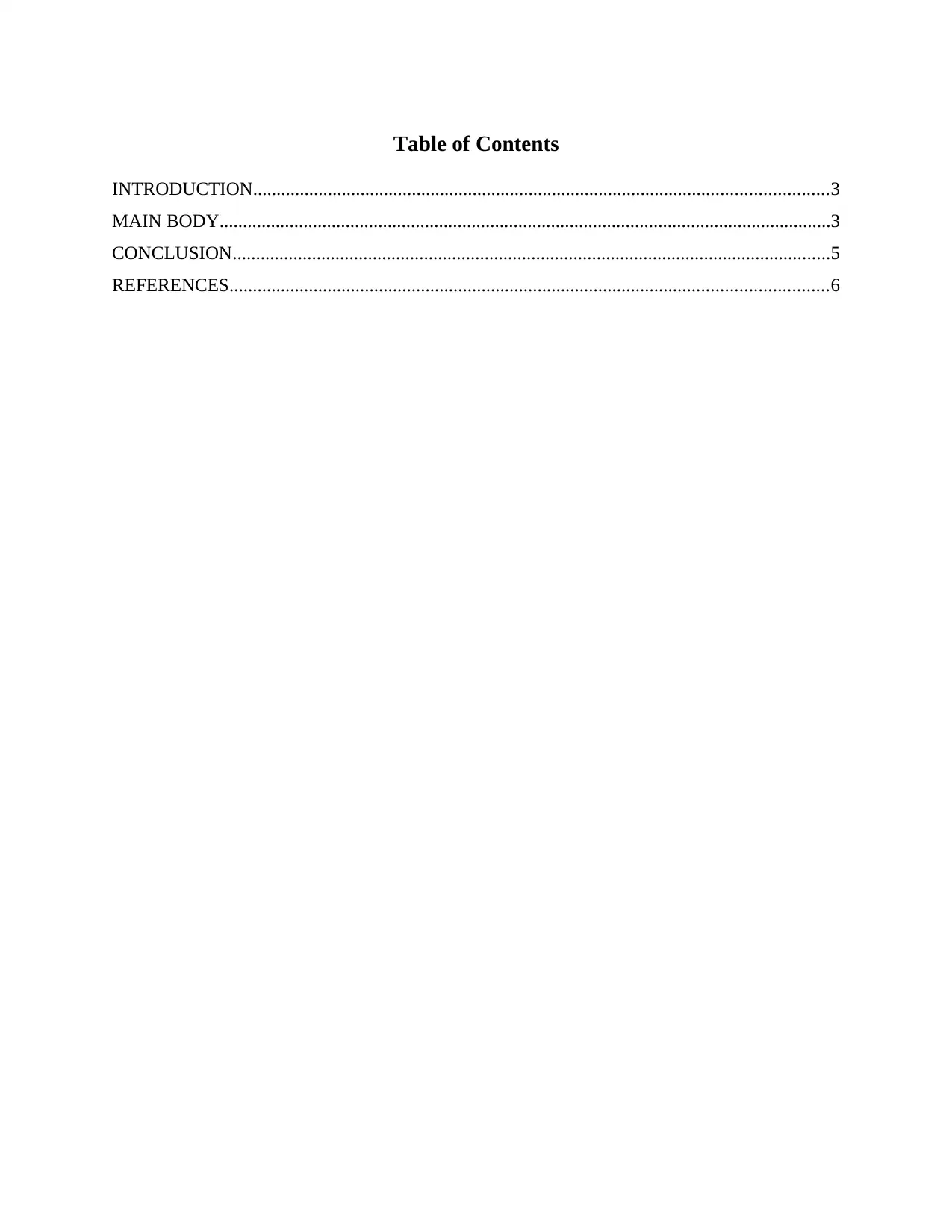
Table of Contents
INTRODUCTION...........................................................................................................................3
MAIN BODY...................................................................................................................................3
CONCLUSION................................................................................................................................5
REFERENCES................................................................................................................................6
INTRODUCTION...........................................................................................................................3
MAIN BODY...................................................................................................................................3
CONCLUSION................................................................................................................................5
REFERENCES................................................................................................................................6
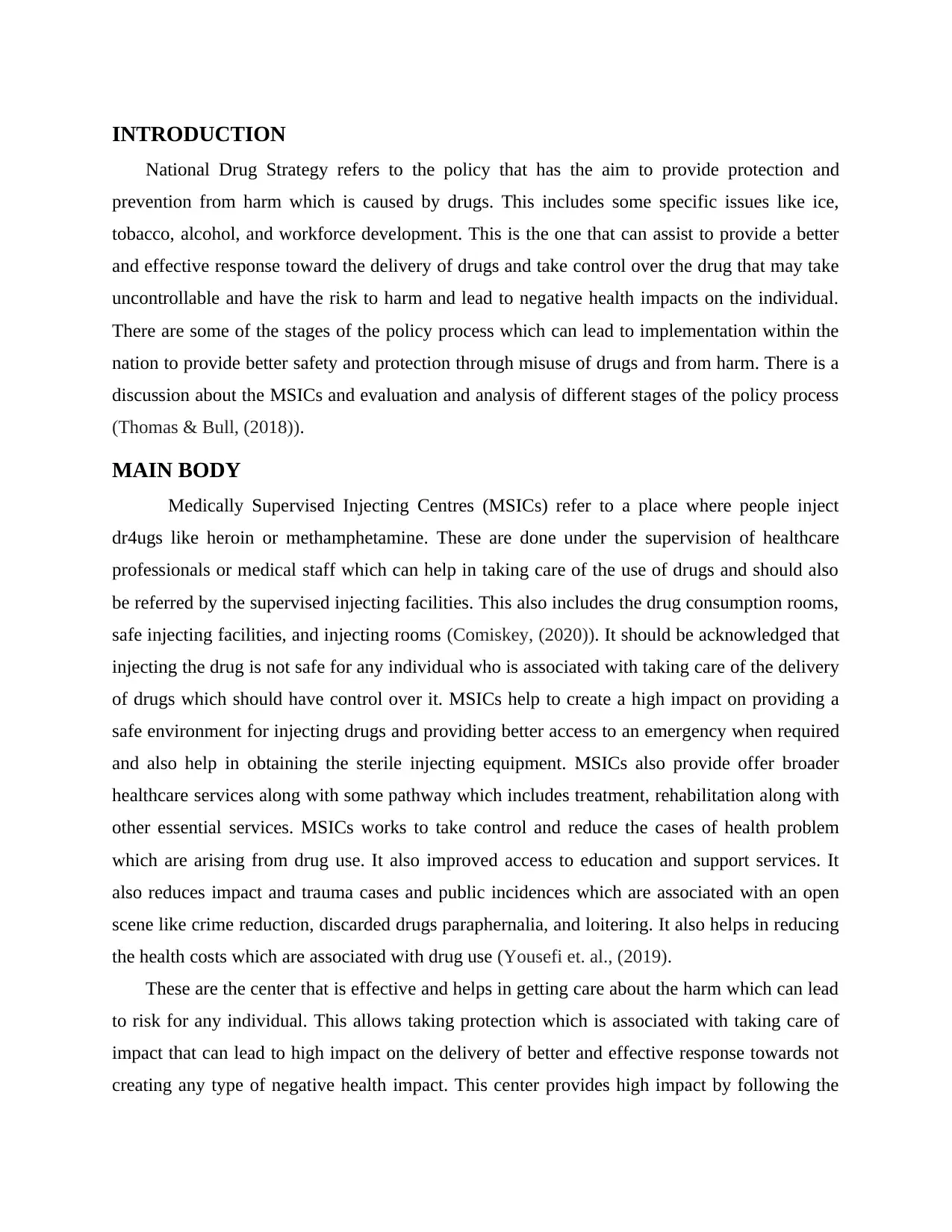
INTRODUCTION
National Drug Strategy refers to the policy that has the aim to provide protection and
prevention from harm which is caused by drugs. This includes some specific issues like ice,
tobacco, alcohol, and workforce development. This is the one that can assist to provide a better
and effective response toward the delivery of drugs and take control over the drug that may take
uncontrollable and have the risk to harm and lead to negative health impacts on the individual.
There are some of the stages of the policy process which can lead to implementation within the
nation to provide better safety and protection through misuse of drugs and from harm. There is a
discussion about the MSICs and evaluation and analysis of different stages of the policy process
(Thomas & Bull, (2018)).
MAIN BODY
Medically Supervised Injecting Centres (MSICs) refer to a place where people inject
dr4ugs like heroin or methamphetamine. These are done under the supervision of healthcare
professionals or medical staff which can help in taking care of the use of drugs and should also
be referred by the supervised injecting facilities. This also includes the drug consumption rooms,
safe injecting facilities, and injecting rooms (Comiskey, (2020)). It should be acknowledged that
injecting the drug is not safe for any individual who is associated with taking care of the delivery
of drugs which should have control over it. MSICs help to create a high impact on providing a
safe environment for injecting drugs and providing better access to an emergency when required
and also help in obtaining the sterile injecting equipment. MSICs also provide offer broader
healthcare services along with some pathway which includes treatment, rehabilitation along with
other essential services. MSICs works to take control and reduce the cases of health problem
which are arising from drug use. It also improved access to education and support services. It
also reduces impact and trauma cases and public incidences which are associated with an open
scene like crime reduction, discarded drugs paraphernalia, and loitering. It also helps in reducing
the health costs which are associated with drug use (Yousefi et. al., (2019).
These are the center that is effective and helps in getting care about the harm which can lead
to risk for any individual. This allows taking protection which is associated with taking care of
impact that can lead to high impact on the delivery of better and effective response towards not
creating any type of negative health impact. This center provides high impact by following the
National Drug Strategy refers to the policy that has the aim to provide protection and
prevention from harm which is caused by drugs. This includes some specific issues like ice,
tobacco, alcohol, and workforce development. This is the one that can assist to provide a better
and effective response toward the delivery of drugs and take control over the drug that may take
uncontrollable and have the risk to harm and lead to negative health impacts on the individual.
There are some of the stages of the policy process which can lead to implementation within the
nation to provide better safety and protection through misuse of drugs and from harm. There is a
discussion about the MSICs and evaluation and analysis of different stages of the policy process
(Thomas & Bull, (2018)).
MAIN BODY
Medically Supervised Injecting Centres (MSICs) refer to a place where people inject
dr4ugs like heroin or methamphetamine. These are done under the supervision of healthcare
professionals or medical staff which can help in taking care of the use of drugs and should also
be referred by the supervised injecting facilities. This also includes the drug consumption rooms,
safe injecting facilities, and injecting rooms (Comiskey, (2020)). It should be acknowledged that
injecting the drug is not safe for any individual who is associated with taking care of the delivery
of drugs which should have control over it. MSICs help to create a high impact on providing a
safe environment for injecting drugs and providing better access to an emergency when required
and also help in obtaining the sterile injecting equipment. MSICs also provide offer broader
healthcare services along with some pathway which includes treatment, rehabilitation along with
other essential services. MSICs works to take control and reduce the cases of health problem
which are arising from drug use. It also improved access to education and support services. It
also reduces impact and trauma cases and public incidences which are associated with an open
scene like crime reduction, discarded drugs paraphernalia, and loitering. It also helps in reducing
the health costs which are associated with drug use (Yousefi et. al., (2019).
These are the center that is effective and helps in getting care about the harm which can lead
to risk for any individual. This allows taking protection which is associated with taking care of
impact that can lead to high impact on the delivery of better and effective response towards not
creating any type of negative health impact. This center provides high impact by following the
⊘ This is a preview!⊘
Do you want full access?
Subscribe today to unlock all pages.

Trusted by 1+ million students worldwide
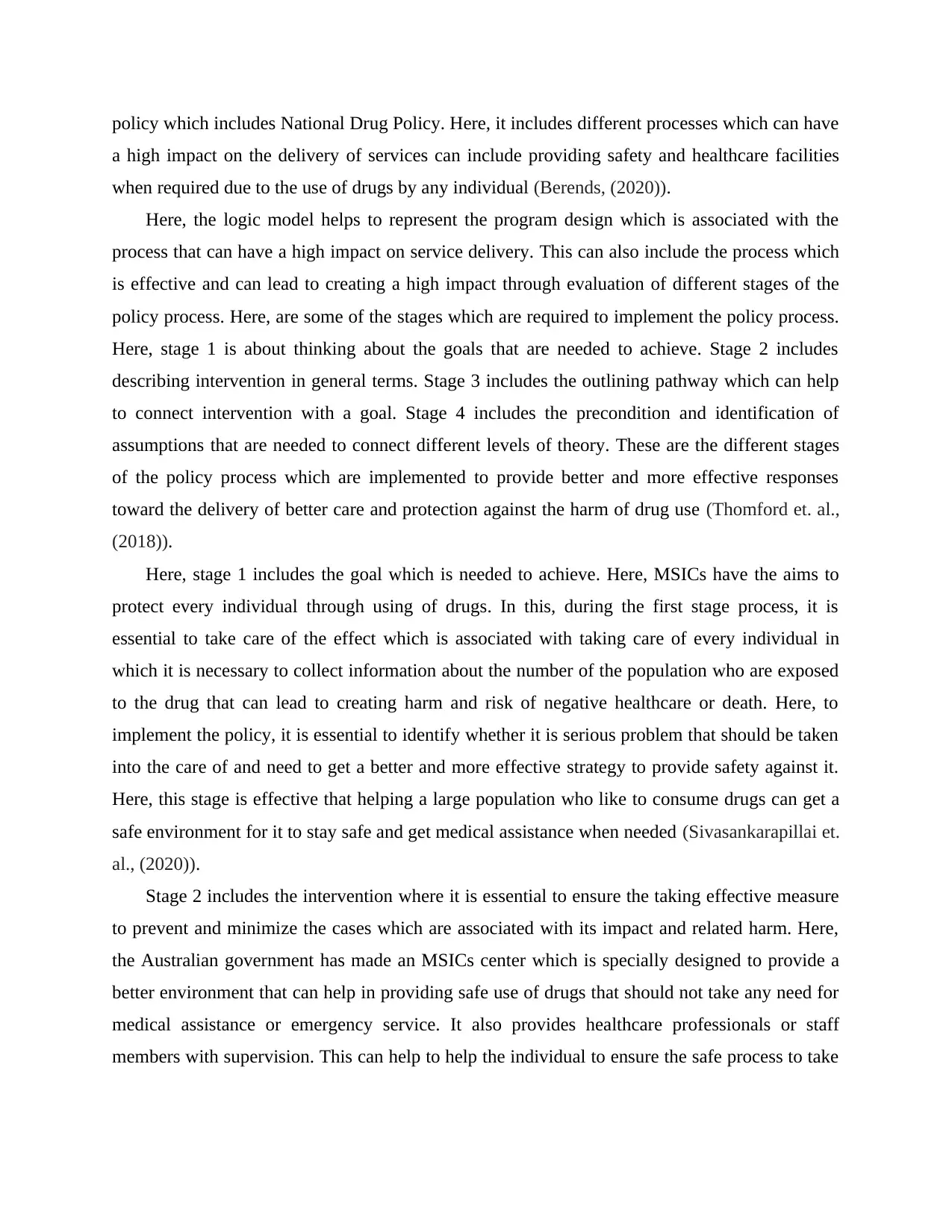
policy which includes National Drug Policy. Here, it includes different processes which can have
a high impact on the delivery of services can include providing safety and healthcare facilities
when required due to the use of drugs by any individual (Berends, (2020)).
Here, the logic model helps to represent the program design which is associated with the
process that can have a high impact on service delivery. This can also include the process which
is effective and can lead to creating a high impact through evaluation of different stages of the
policy process. Here, are some of the stages which are required to implement the policy process.
Here, stage 1 is about thinking about the goals that are needed to achieve. Stage 2 includes
describing intervention in general terms. Stage 3 includes the outlining pathway which can help
to connect intervention with a goal. Stage 4 includes the precondition and identification of
assumptions that are needed to connect different levels of theory. These are the different stages
of the policy process which are implemented to provide better and more effective responses
toward the delivery of better care and protection against the harm of drug use (Thomford et. al.,
(2018)).
Here, stage 1 includes the goal which is needed to achieve. Here, MSICs have the aims to
protect every individual through using of drugs. In this, during the first stage process, it is
essential to take care of the effect which is associated with taking care of every individual in
which it is necessary to collect information about the number of the population who are exposed
to the drug that can lead to creating harm and risk of negative healthcare or death. Here, to
implement the policy, it is essential to identify whether it is serious problem that should be taken
into the care of and need to get a better and more effective strategy to provide safety against it.
Here, this stage is effective that helping a large population who like to consume drugs can get a
safe environment for it to stay safe and get medical assistance when needed (Sivasankarapillai et.
al., (2020)).
Stage 2 includes the intervention where it is essential to ensure the taking effective measure
to prevent and minimize the cases which are associated with its impact and related harm. Here,
the Australian government has made an MSICs center which is specially designed to provide a
better environment that can help in providing safe use of drugs that should not take any need for
medical assistance or emergency service. It also provides healthcare professionals or staff
members with supervision. This can help to help the individual to ensure the safe process to take
a high impact on the delivery of services can include providing safety and healthcare facilities
when required due to the use of drugs by any individual (Berends, (2020)).
Here, the logic model helps to represent the program design which is associated with the
process that can have a high impact on service delivery. This can also include the process which
is effective and can lead to creating a high impact through evaluation of different stages of the
policy process. Here, are some of the stages which are required to implement the policy process.
Here, stage 1 is about thinking about the goals that are needed to achieve. Stage 2 includes
describing intervention in general terms. Stage 3 includes the outlining pathway which can help
to connect intervention with a goal. Stage 4 includes the precondition and identification of
assumptions that are needed to connect different levels of theory. These are the different stages
of the policy process which are implemented to provide better and more effective responses
toward the delivery of better care and protection against the harm of drug use (Thomford et. al.,
(2018)).
Here, stage 1 includes the goal which is needed to achieve. Here, MSICs have the aims to
protect every individual through using of drugs. In this, during the first stage process, it is
essential to take care of the effect which is associated with taking care of every individual in
which it is necessary to collect information about the number of the population who are exposed
to the drug that can lead to creating harm and risk of negative healthcare or death. Here, to
implement the policy, it is essential to identify whether it is serious problem that should be taken
into the care of and need to get a better and more effective strategy to provide safety against it.
Here, this stage is effective that helping a large population who like to consume drugs can get a
safe environment for it to stay safe and get medical assistance when needed (Sivasankarapillai et.
al., (2020)).
Stage 2 includes the intervention where it is essential to ensure the taking effective measure
to prevent and minimize the cases which are associated with its impact and related harm. Here,
the Australian government has made an MSICs center which is specially designed to provide a
better environment that can help in providing safe use of drugs that should not take any need for
medical assistance or emergency service. It also provides healthcare professionals or staff
members with supervision. This can help to help the individual to ensure the safe process to take
Paraphrase This Document
Need a fresh take? Get an instant paraphrase of this document with our AI Paraphraser
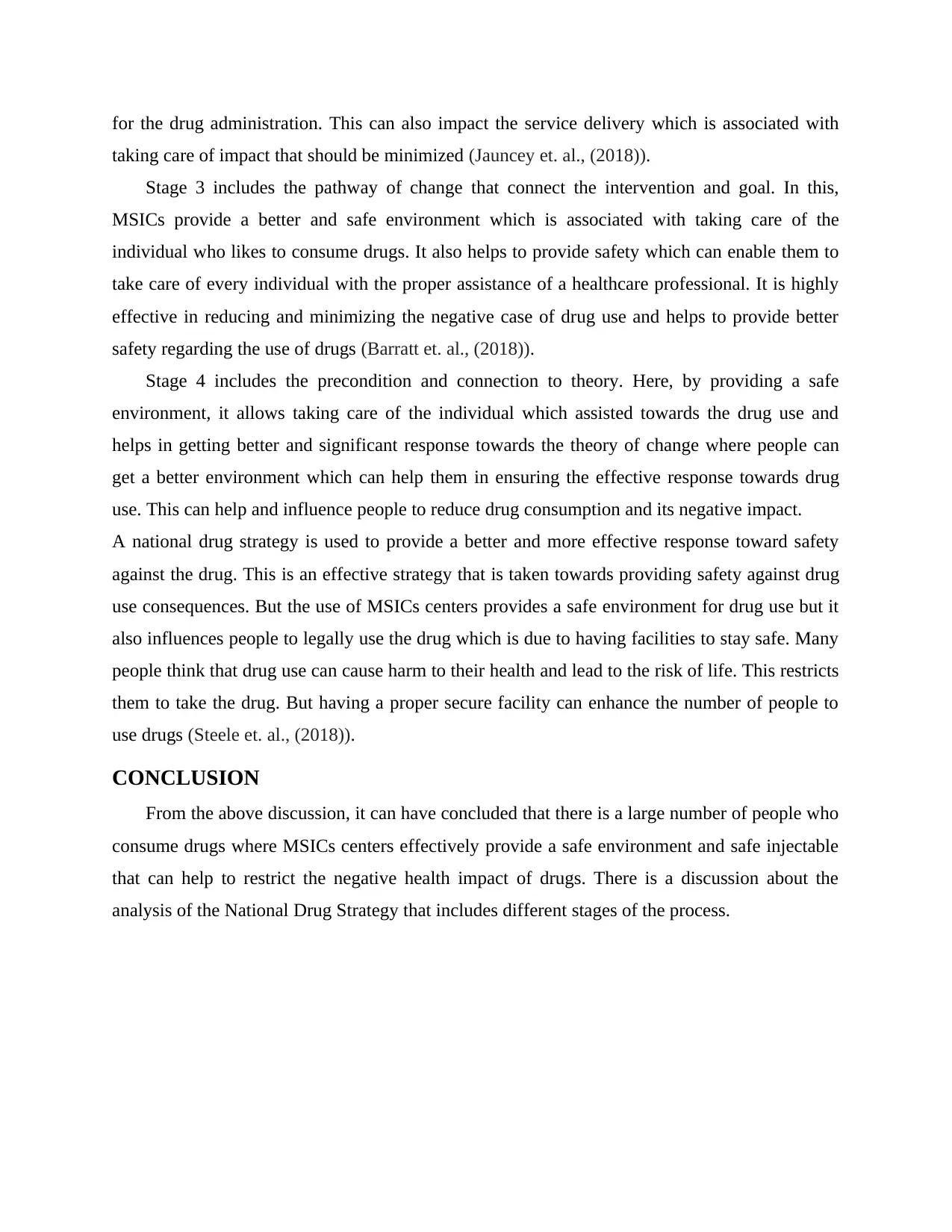
for the drug administration. This can also impact the service delivery which is associated with
taking care of impact that should be minimized (Jauncey et. al., (2018)).
Stage 3 includes the pathway of change that connect the intervention and goal. In this,
MSICs provide a better and safe environment which is associated with taking care of the
individual who likes to consume drugs. It also helps to provide safety which can enable them to
take care of every individual with the proper assistance of a healthcare professional. It is highly
effective in reducing and minimizing the negative case of drug use and helps to provide better
safety regarding the use of drugs (Barratt et. al., (2018)).
Stage 4 includes the precondition and connection to theory. Here, by providing a safe
environment, it allows taking care of the individual which assisted towards the drug use and
helps in getting better and significant response towards the theory of change where people can
get a better environment which can help them in ensuring the effective response towards drug
use. This can help and influence people to reduce drug consumption and its negative impact.
A national drug strategy is used to provide a better and more effective response toward safety
against the drug. This is an effective strategy that is taken towards providing safety against drug
use consequences. But the use of MSICs centers provides a safe environment for drug use but it
also influences people to legally use the drug which is due to having facilities to stay safe. Many
people think that drug use can cause harm to their health and lead to the risk of life. This restricts
them to take the drug. But having a proper secure facility can enhance the number of people to
use drugs (Steele et. al., (2018)).
CONCLUSION
From the above discussion, it can have concluded that there is a large number of people who
consume drugs where MSICs centers effectively provide a safe environment and safe injectable
that can help to restrict the negative health impact of drugs. There is a discussion about the
analysis of the National Drug Strategy that includes different stages of the process.
taking care of impact that should be minimized (Jauncey et. al., (2018)).
Stage 3 includes the pathway of change that connect the intervention and goal. In this,
MSICs provide a better and safe environment which is associated with taking care of the
individual who likes to consume drugs. It also helps to provide safety which can enable them to
take care of every individual with the proper assistance of a healthcare professional. It is highly
effective in reducing and minimizing the negative case of drug use and helps to provide better
safety regarding the use of drugs (Barratt et. al., (2018)).
Stage 4 includes the precondition and connection to theory. Here, by providing a safe
environment, it allows taking care of the individual which assisted towards the drug use and
helps in getting better and significant response towards the theory of change where people can
get a better environment which can help them in ensuring the effective response towards drug
use. This can help and influence people to reduce drug consumption and its negative impact.
A national drug strategy is used to provide a better and more effective response toward safety
against the drug. This is an effective strategy that is taken towards providing safety against drug
use consequences. But the use of MSICs centers provides a safe environment for drug use but it
also influences people to legally use the drug which is due to having facilities to stay safe. Many
people think that drug use can cause harm to their health and lead to the risk of life. This restricts
them to take the drug. But having a proper secure facility can enhance the number of people to
use drugs (Steele et. al., (2018)).
CONCLUSION
From the above discussion, it can have concluded that there is a large number of people who
consume drugs where MSICs centers effectively provide a safe environment and safe injectable
that can help to restrict the negative health impact of drugs. There is a discussion about the
analysis of the National Drug Strategy that includes different stages of the process.
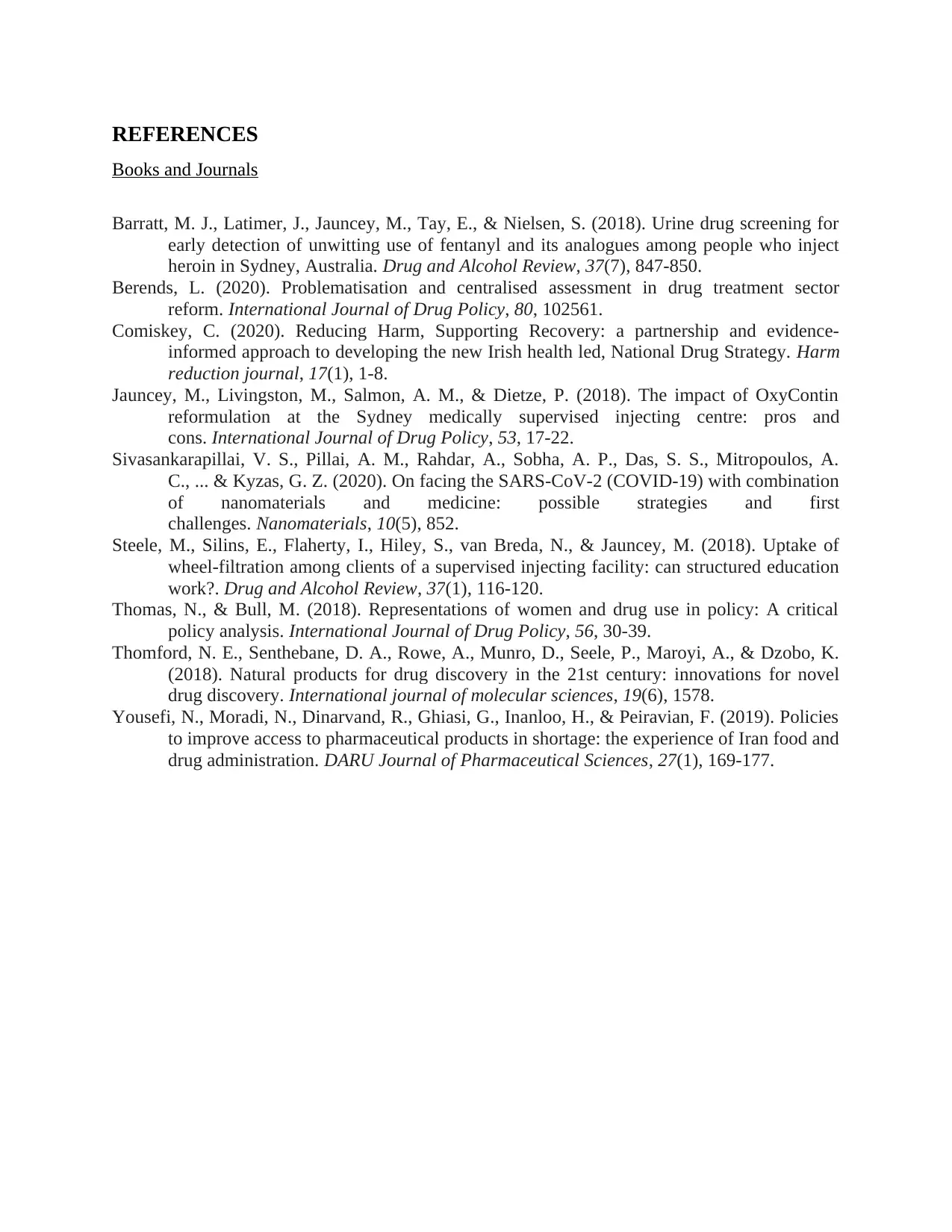
REFERENCES
Books and Journals
Barratt, M. J., Latimer, J., Jauncey, M., Tay, E., & Nielsen, S. (2018). Urine drug screening for
early detection of unwitting use of fentanyl and its analogues among people who inject
heroin in Sydney, Australia. Drug and Alcohol Review, 37(7), 847-850.
Berends, L. (2020). Problematisation and centralised assessment in drug treatment sector
reform. International Journal of Drug Policy, 80, 102561.
Comiskey, C. (2020). Reducing Harm, Supporting Recovery: a partnership and evidence-
informed approach to developing the new Irish health led, National Drug Strategy. Harm
reduction journal, 17(1), 1-8.
Jauncey, M., Livingston, M., Salmon, A. M., & Dietze, P. (2018). The impact of OxyContin
reformulation at the Sydney medically supervised injecting centre: pros and
cons. International Journal of Drug Policy, 53, 17-22.
Sivasankarapillai, V. S., Pillai, A. M., Rahdar, A., Sobha, A. P., Das, S. S., Mitropoulos, A.
C., ... & Kyzas, G. Z. (2020). On facing the SARS-CoV-2 (COVID-19) with combination
of nanomaterials and medicine: possible strategies and first
challenges. Nanomaterials, 10(5), 852.
Steele, M., Silins, E., Flaherty, I., Hiley, S., van Breda, N., & Jauncey, M. (2018). Uptake of
wheel‐filtration among clients of a supervised injecting facility: can structured education
work?. Drug and Alcohol Review, 37(1), 116-120.
Thomas, N., & Bull, M. (2018). Representations of women and drug use in policy: A critical
policy analysis. International Journal of Drug Policy, 56, 30-39.
Thomford, N. E., Senthebane, D. A., Rowe, A., Munro, D., Seele, P., Maroyi, A., & Dzobo, K.
(2018). Natural products for drug discovery in the 21st century: innovations for novel
drug discovery. International journal of molecular sciences, 19(6), 1578.
Yousefi, N., Moradi, N., Dinarvand, R., Ghiasi, G., Inanloo, H., & Peiravian, F. (2019). Policies
to improve access to pharmaceutical products in shortage: the experience of Iran food and
drug administration. DARU Journal of Pharmaceutical Sciences, 27(1), 169-177.
Books and Journals
Barratt, M. J., Latimer, J., Jauncey, M., Tay, E., & Nielsen, S. (2018). Urine drug screening for
early detection of unwitting use of fentanyl and its analogues among people who inject
heroin in Sydney, Australia. Drug and Alcohol Review, 37(7), 847-850.
Berends, L. (2020). Problematisation and centralised assessment in drug treatment sector
reform. International Journal of Drug Policy, 80, 102561.
Comiskey, C. (2020). Reducing Harm, Supporting Recovery: a partnership and evidence-
informed approach to developing the new Irish health led, National Drug Strategy. Harm
reduction journal, 17(1), 1-8.
Jauncey, M., Livingston, M., Salmon, A. M., & Dietze, P. (2018). The impact of OxyContin
reformulation at the Sydney medically supervised injecting centre: pros and
cons. International Journal of Drug Policy, 53, 17-22.
Sivasankarapillai, V. S., Pillai, A. M., Rahdar, A., Sobha, A. P., Das, S. S., Mitropoulos, A.
C., ... & Kyzas, G. Z. (2020). On facing the SARS-CoV-2 (COVID-19) with combination
of nanomaterials and medicine: possible strategies and first
challenges. Nanomaterials, 10(5), 852.
Steele, M., Silins, E., Flaherty, I., Hiley, S., van Breda, N., & Jauncey, M. (2018). Uptake of
wheel‐filtration among clients of a supervised injecting facility: can structured education
work?. Drug and Alcohol Review, 37(1), 116-120.
Thomas, N., & Bull, M. (2018). Representations of women and drug use in policy: A critical
policy analysis. International Journal of Drug Policy, 56, 30-39.
Thomford, N. E., Senthebane, D. A., Rowe, A., Munro, D., Seele, P., Maroyi, A., & Dzobo, K.
(2018). Natural products for drug discovery in the 21st century: innovations for novel
drug discovery. International journal of molecular sciences, 19(6), 1578.
Yousefi, N., Moradi, N., Dinarvand, R., Ghiasi, G., Inanloo, H., & Peiravian, F. (2019). Policies
to improve access to pharmaceutical products in shortage: the experience of Iran food and
drug administration. DARU Journal of Pharmaceutical Sciences, 27(1), 169-177.
⊘ This is a preview!⊘
Do you want full access?
Subscribe today to unlock all pages.

Trusted by 1+ million students worldwide
1 out of 6
Related Documents
Your All-in-One AI-Powered Toolkit for Academic Success.
+13062052269
info@desklib.com
Available 24*7 on WhatsApp / Email
![[object Object]](/_next/static/media/star-bottom.7253800d.svg)
Unlock your academic potential
Copyright © 2020–2025 A2Z Services. All Rights Reserved. Developed and managed by ZUCOL.





